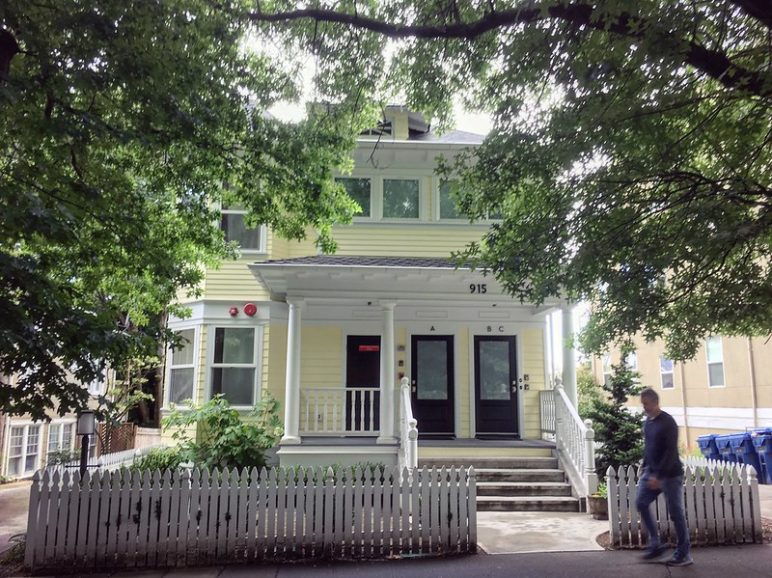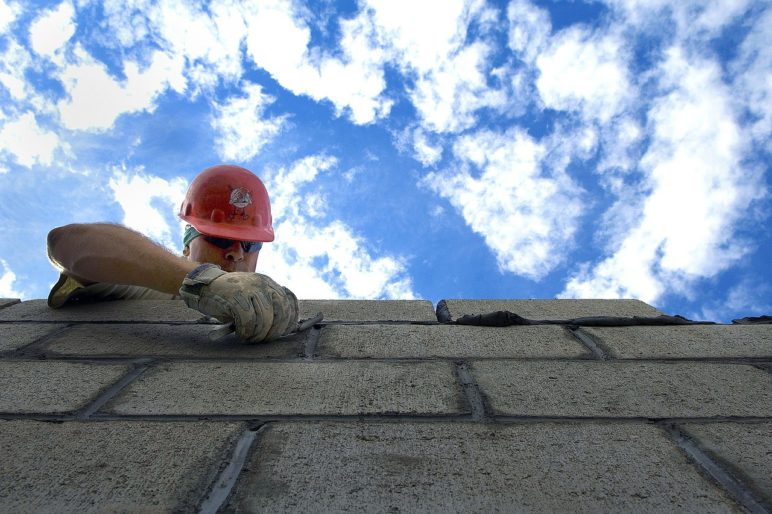Mark it down: It was in late 2019 that Alexandria Ocasio-Cortez introduced parking reform to the halls of Congress.
The New York Congresswoman’s call to withhold federal transportation funding from any jurisdiction that bans car-free homes by requiring on-site parking, unveiled Sept. 25 as part of a large and ambitious housing bill, is the latest thump in an accelerating riff of new pro-housing proposals that is starting to rattle mainstream US politics.
This drumbeat of new ideas is coming three years after Chicago-based policy writer Daniel Kay Hertz scoured the major party platforms for new housing ideas and found almost nothing.

(In case you were wondering: under this bill, only three or four major cities in the United States would currently qualify for a share of $43 billion in annual federal highway formula spending. If it became law, that’d change fast, and the change would allow many, many more homes to be built for lower prices, especially in transit-rich areas. It’d be a crucial plank in any Green New Deal.)
This drumbeat of new ideas is coming three years after Chicago-based policy writer Daniel Kay Hertz scoured the major party platforms for new housing ideas and found almost nothing.
In a prescient Nation article last year, Henry Kraemer and Sean McElwee (both affiliated with Data for Progress, a think tank that specializes in unexpectedly popular left-wing ideas) identified an opening for federal candidates to mobilize younger voters, especially renters, with housing policy proposals.
“Elected leaders have paid little attention to housing, and even less to renters,” they argued. “That’s been horrendous policy—and also terrible politics.”
That message seems to have been heard, and not only by the left.
Federal housing bills aren’t new, of course. Democrats have long tried to improve outcomes by spending more public money; Republicans have long tried to force efficiency by spending less.
What’s new is the idea that in either case, we’d be better off if we re-legalized greener, less expensive home types like apartments, fourplexes and backyard cottages in more places, especially the most exclusive ones.
Summer 2019: A rush of new ideas from both major parties

Federal leaders are increasingly looking for ways to push cities to lift bans on homes like these, in a Seattle triplex that was built before the city banned them from low-density zones. Photo by Sightline Institute: Missing Middle Homes Photo Library used under CC BY 2.0
Just like grassroots pro-housing advocates, US politicians are embracing abundant housing for various reasons: giving more people the American dream of a safe and stable home; helping more people cut their energy bills and carbon emissions; racially and economically integrating our schools; preserving the middle class; allowing economic growth; making it easier for poor people to exist.
Lifting bans on attached, manufactured and car-free homes helps more people live where they want in the ways they want for less money. It makes every Section 8 voucher go further. It reduces displacement by letting exclusive neighborhoods absorb their share of growth. It lets cities respond to economic growth the way they once could, by sharing the benefits of a prosperous city with newcomers rather than heaping windfalls on people lucky enough to already own land.
Though housing policy has yet to come up in a debate, zoning reform is suddenly a common plank in Democratic Party presidential platforms. Senators Cory Booker, Elizabeth Warren, Amy Kloubuchar and Bernie Sanders, and former Housing and Urban Development Secretary Julian Castro, all want federal funding to reward abundant-housing policies. (Kraemer and Peter Harris have been keeping useful summaries at Data for Progress.)
The YIMBY Act, introduced in July by Indiana Republican Sen. Todd Young and Hawaii Democratic Sen. Brian Schatz, would apply this idea to federal community development funds. Two weeks ago, a similarly bipartisan crew of sponsors that included Cascadians from both major parties (Democratic Rep. Denny Heck of Olympia and Republican Rep. Jaime Herrera Buetler of Ridgefield) introduced the companion House bill.
“A larger federal role in reducing local barriers to development appears to be one area with potential for bipartisan cooperation,” wrote the Brookings Institution’s Jenny Schuetz in July.
Heck and Republican Cathy McMorris Rodgers, of eastern Washington, are also cosponsors of the Build More Housing Near Transit Act introduced last month by San Diego Democrat Scott Peters. That bill would base federal transit grants more closely on whether cities have also legalized additional homes nearby, both market-rate and below-market, to help more people take advantage of the new trains and buses.
Abundant housing is good no matter who is building the homes

Image by David Mark from Pixabay, used with permission.
This fall’s new bill from Ocasio-Cortez, though, is the most ambitious on housing abundance by far. In addition to the huge penalty for cities that refuse to end parking quotas, it would also penalize cities that ban apartments and mobile parks and reward cities for re-legalizing backyard cottages and taxing vacant land.
There’s more in her bill. (Federal investment in lead cleanup is long overdue.) One provision that’s drawn criticism is her proposed 3 percent cap on most rent hikes, even in new buildings. Even sympathetic analysis of rent regulation usually concedes that capping price hikes in new buildings might backfire on poor tenants by triggering drops in rental construction, leading to rock-bottom vacancy rates and high prices when people need to move. But Sanders’ plan, which also caps rents in new buildings, offers a way to correct this: spending $2 trillion to build 9 million new or rehabbed homes over 10 years. If that were to actually happen—Sanders wants to pay for it with a wealth tax—it would account for about 80 percent of current annual homebuilding, likely enough to offset the drop in private construction.
In any case, it’s a similar story either way. Whether the United States were to “decommodify housing” by socializing the rental homebuilding industry, or keep using its current, privately financed system, the country would be able to help far more people if we lift bans on apartments, backyard cottages, mobile parks and car-free homes.
That’s the great promise of abundant-housing policies like the ones Ocasio-Cortez proposes: They’re good ideas no matter what your preferred system is for homebuilding.
Abundant housing would make capitalism better; abundant housing would make socialism better.
“Anything that we can do to encourage more infill and housing stock within our cities is just really important,” said Joel Madsen, executive director of the Mid-Columbia Housing Authority in Hood River, Oregon. Madsen supported Oregon’s recent legalization of “missing middle” housing—the sort of reform Ocasio-Cortez’s bill would incentivize—because he thinks it’ll create more homes in the price range that one of his agency’s Section 8 vouchers can subsidize.
“I’m not saying that supply is the only solution to our housing challenge by any means,” Madsen said. “Supply is part of the solution.”
He’s exactly right. Abundant housing doesn’t, in itself, end housing inequality. But it makes every wallet fatter by making every dollar, public and private, go further. Wages buy more. Salaries compete better. Vouchers house more kids. It’s easier for any entrepreneur to turn a great idea into a great job. It’s easier to keep a roof over your head.
Abundance makes every other problem, including inequality, easier to solve.
Most of us know what abundance feels like from other parts of our lives: a grocery store, a streaming-video website, a public library. Abundance lets us enjoy good things without joining a war of all against all. We should be working together to bring the same feeling of abundance to our housing purchases.
Don’t worry, that’ll still leave plenty of other important things to disagree about.











Steve Erickson
However, expect to see efforts to “bust” GMA in Washington by using the “affordable” housing umbrella to allow more suburban sprawl and rural densification outside UGAs. As for within UGAs, there seems to be an assumption that increased density (ADU’s, etc.) will result automatically in “affordable” housing. I many instances its just going to result in vacation rentals and Air B & Bs.
John Hartshorn
There’s no mention of increased energy efficiency in this article, although perhaps it’s covered in the pending legislation. The pressing need to transition to a clean energy future with the goal of eliminating CO2 emissions should be a key component of any housing bill today, since conservation efforts via increased efficiency usually pay for themselves over the life of the structure. Super-insulation, optimal siting and window location to minimize heat loss and cooling needs, geothermal heat pumps, etc. should all be encouraged today in any new housing.
Michael Andersen
All of the above!
Some energy efficiency standards may deter the “optimal siting” part of the formula by driving up costs so much that a bunch more people land in old homes or the exurbs. But that’s a balancing act.